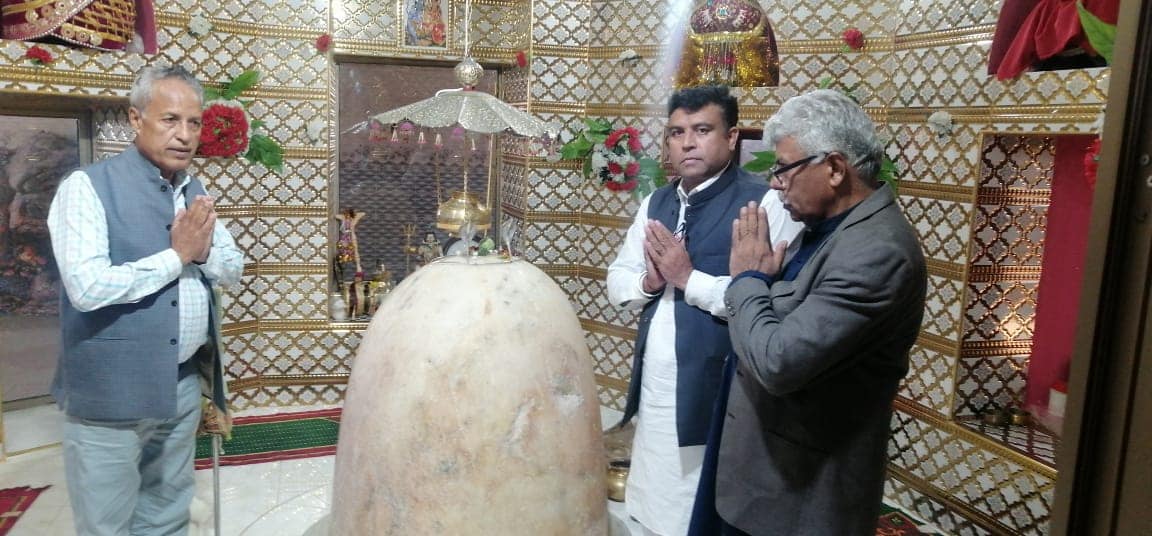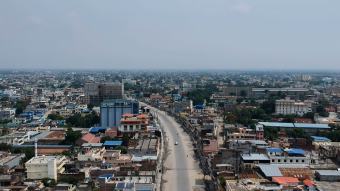Nepali Yogis and ‘Tilla Yogiyan’




Eminent Nepali scholar Dr. Bholanath Yogi, who is known as a social worker and Natha Yogi expert, came to Lahore to attend the World Religions Conference 2023. After participating in the conference, he arrived at the Nepali Embassy in Islamabad. Ambassador Mr. Tapas Adhikari arranged Dr. Yogi’s lecture on “Nath Tradition in Nepal and Pakistan” on 2nd November 2023 at the Embassy.
Participating in this academic session was of great interest to me because Indus Valley Civilization, Anthropology and History are my favorite subjects. In Sindh province, Jogi (Yogi) nomadic tribes spread from the Thar desert to the Sangalakh hill region of Koh Sulaiman (Sulaiman Mountain Range). Sufi poets of Sindh, especially Shah Abdul Latif Bhitai, mention about these Jogi (Yogi) and Naths in their poetry. This background and in the search for answers to a few related questions convinced me to attend this academic session.
About 143 km from Islamabad, “Tilla Yogiyan” is the second highest peak of Koh Namak (Salt Mountain Range) which is 3,200 feet above the sea level. The peak has a dense forest of Kikar and wild olive trees which adds to its charismatic attraction. According to ancient traditions, the foundation of this monastery at “Tilla Yogiyan” was laid by Gorakhnath, the founder of ‘Kan Phate’ Yogi, a century before Christ. This monastery was inhabited for two thousand years. Waris Shah has also cited “Tilla Yogiyan” and monastery in his famous poem “Heer Ranjha”. A monument of Jogi (Yogi) of Rranjha called “Takht Nama Pathar” is still existent at “Tilla Yogiyan.”
In ancient times, some Maha Purusha (Great Being) had built a place of worship here. (It is believed that) at the end of Maha Bharata, the five Pandavas came here for pilgrimage. The Jogi (Yogi) who lived at the “Tilla Yogiyan” remained engaged in meditation; these same Jogis (Yogis) introduced the Ayurvedic treatment. The art of herbal treatment, astrology, eight watches of the day-night (24 hours) for determining the time are also compiled by the same Jogi (Yogi). The invention and rules of yoga are also owed to these Yogis. Yogis living on the hills used to search for herbs in forests away from human settlements.
Tilla Yogiyan
Abul Fazl, a historian devoted to the Mughal Emperor Jalaluddin’s court, writes that Jalaluddin Akbar visited “Tilla Yogiyan” twice. In 1581 he built a pond for the Jogis living on Tilla, the remains of which are present in “Tilla Yogiyan”. Abul Fazl has also mentioned about Balak Nath. Emperor Jahangir encamped in Rohtas Fort in 1607 and established a court in “Tilla Yogiyan”. This abode of Jogi (Yogi) has been the best example of religious harmony in the subcontinent, where Jogi (Yogi) of every religion could practice their worship liberally.
The Gorkha Kingdom established in Nepal in the 18th century was actually devoted to Guru Gorakhnath. According to a legend, the area where Gorakhnath appeared for the first time in Nepal was named “Gorkha” and there is a cave with his footprints existed there. A large number of followers of Gorakhnath still live in Nepal today. Highlighting the tradition of “Tilla Yogiyan” and philosophy of Gorakhnath located in the Potohar region, Dr. Yogi said that some mandalas and mantras of the Rig Veda were created here.
“Tilla Yogiyan” provided salve to Gorakhnath, Balaknath, Guru Nanak, Raja Slohan, Raja Bhartrihari, Alexander the Great, Jalaluddin Akbar, Nooruddin Jahangir, Ranjha of Heer, and had been providing salve to the sultans and the bereaved in every era. Gorakhnath pitched his camp at “Tilla Yogiyan” during the reign of Raja Vikramaditya and established the Nath Panth according to the teachings of Maha Yogi Shiva. Personalities like Raja Bhratrihari and Pooran Bhagat belong to Gorakhnath’s era.
‘Nath,’ also spelled ‘Natha,’ is a Sanskrit word literally meaning “Sahara” (protector), Malik (Master) and Guru (Lord). In fact, it was a medieval movement that emerged as a reaction against religious extremism in the society and the artificial difficulties faced in performing religious rituals. This movement negates any barrier between man and his Creator. This movement combined the traditions of Buddhism and Shaivism. Naths remains a union of devotees who consider Shiva as their Guru.
Followers of this tradition are called Yogis. Nath tradition also has root in Yogic and Tantric practices. These traditions include a variety of philosophies derived from both Shaivism and Tantric practices. Central to this philosophy is the attainment of self-realization and spiritual maturity. They emphasize the unity of the individual soul with the universal consciousness. Nath advocates that self-purification is possible through discipline and meditation.
Spiritual Heritage
Nath Yogis are known for their dedication to penance. They take a holistic approach in which physical and mental exercises are central to their spiritual journey. Nath traditions represent the rich and diverse spiritual heritage of the subcontinent. This movement challenged traditional beliefs by exploring unconventional aspects of society to understand theology.
Yogi built monasteries; created wandering groups who embarked on spiritual journeys and connected themselves with nature in search of the Absolute in the wilderness. This movement also had a profound influence on other movements including Vedanta, Vaishnavism and Bhakti movement. Namdev and Bhagat Kabir were also influenced by the Nath tradition.
In the neo-demographic era, the Yogis were included as a lower caste during the statistical survey, in response to which the Yogis began to use the term “Nath” more prominently in their social contacts. In today’s turbulent times, the need for inter-religious dialogue for the peaceful co-existence is a priotiy. The purpose of interfaith dialogue is not only to acknowledge each other’s existence, but to respect each other’s views while remaining in variance.
The sub-continent of South Asia is the land in which the vast and fertile plains of the Indus and the Ganges are located. The Indus and Ganges rivers irrigate this plain. This field extends to four countries Pakistan, India, Bangladesh and Nepal. The oldest traces of human civilization exist in this region. If we look for the earliest evidence of human settlement in Punjab only, according to experts, this evidence is found in the Son valley of Potohar. Remains of stone and flint tools have been found here. The ruins of the Gandhara Civilization, which is included in the UNESCO World Heritage list, are located in Taxila. Similarly, Harappa, Mohenjodaro, Kot Diji, Mehrgarh etc. are well-known archaeological sites. If only one Potohar region is seen from a historical point of view, Rohtas Fort, Katas Raj, Rawat Fort, Mankyala Stupa on the way to “Tilla Yogiyan” are the historical places which in the distant past had been the center of the wandering people in search of the absolute truth.
By restoring these great places of history, not only the rich history of diverse spiritual traditions of the land of Pakistan can be brought to the world, but also by the promotion of religious tourism at the government level, thousands of tourists from all over the world can be brought to Pakistan every year.
(This article was translated from Urdu into English by Dr. Rano Mal Piryani).











